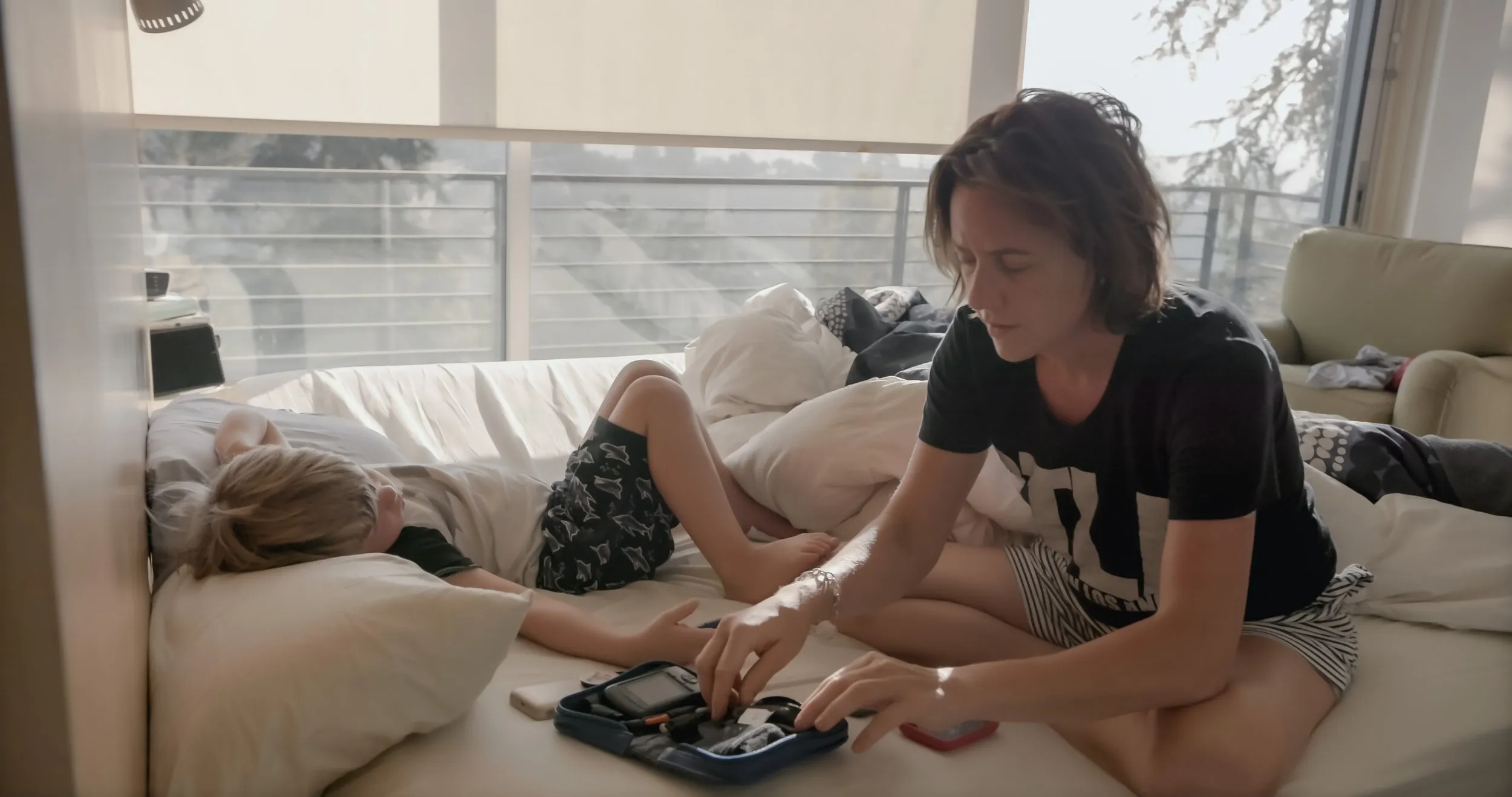
Lisa Hepner: The long wait for the cure of diabetes
In the three decades since he was diagnosed with type 1 diabetes, Lisa Hepner has clung to a vague promise he frequently listened to doctors convinced that medical science was about to repair his body."Be strong," they said."In just five years we will have a cure."
The Times a weekly selection of Spanish stories that you will not find anywhere else, with eñes and accents.Get it feels your inbox.
But the cure still does not arrive and Hepner, a 51 -year -old filmmaker from Los Angeles, remains limited by the impossibility of his body to produce insulin, the hormone that regulates the sugar produced by the pancreas."Maybe for you I look good," he said, "but 70 percent of the time I feel fatal."
For many of the 37 million Americans suffering from some type of diabetes, staying healthy can be strenuous.Day and night, they have to monitor their sugar levels;They need constant insulin injections to survive;And in addition, the possible threats of the perverse complications of diabetes are present: heart disease, blindness, renal damage and the probability that they ampute some gangrenous limb.
"‘ In five years we will have the cure ’it has become a joke within the Diabetic Community," Hepner said.“If you are so close, then why does it take so long?And while arriving, millions of us have died. ”
The worn out of hope led Hepner to spend almost a decade following the vicissitudes of Viacyte, a small biotechnology company in San Diego that works to produce what, deep down, turns out to be an artificial pancreas.If it succeeds, its treatment -based treatment would eliminate the punctures and insulin injections that limit the life of 1.5 million Americans with type 1 diabetes. VERTEX Pharmaceuticals, a Boston biotechnology company that is developing a similar therapy, has already achieved significant advance.
Since he saw the light in theaters in the month of June, The Human Trial, the documentary he produced together with her husband, Guy Mossman, has shaken the Diabetics community, especially those who have type 1 diabetes, a diseasethat is confused with type 2 diabetes, which is more common, by those who are not familiar with it.
Unlike type 2 diabetes, which tends to appear gradually in adulthood and can sometimes be reversed in the beginning with exercise or diet changes, type 1 is an autoimmune disease that almost always comes without prior notice inChildhood or adolescence.
Type 1 diabetes is also much less frequent and affects more or less 10 percent of diabetics.It is possible to cure the disease through a pancreas transplant, but organ donation is scarce and surgery involves important risks.In the United States, almost every year, only a thousand transplants are made.In order to ensure that the body does not reject the transplanted pancreas, receptors must take immunosuppressive medications all their lives, which makes them more susceptible to infections.
Many specialists affirm that the therapies developed from embryo stem cells provide the best hope of finding a enduring cure.The film The Human Trial provides us with an exceptional look at the complexities and challenges that present the development of new treatments, both for patients offered as volunteers for exhausting clinical trials requesting food and medicines administration, and forViacyte managers who constantly cost a lot of work to raise the money needed to launch a new medicine to the market.At present, the average cost, including a large number of failed testsIn the process it is one billion dollars.
At a time when the upward price of insulin and other drugs that keep patients alive has harmed the perception of the population of the pharmaceutical industry, this documentary is also remarkable for its admirarative representation of a biotechnology companywhose managers and employees seem genuinely committed to helping humanity.(Limiting the cost of insulin remains politically sensitive. On August 7, during a marathon vote for the health and environmental bill of the Democrats, the Republicans imposed the elimination of a clause that puts a stop of $ 35At insulin prices for patients with private insurance, although this limit was maintained for Medicare patients).
The Human Trial, which can also be seen online, has become a war cry for patients with type 1 diabetes, many of whom believe that only thanks to greater visibility the money needed for the research that would carry would be obtainedTo find a cure.
Those who have seen the documentary have also comforted themselves when their own battles and frustrated hopes are reflected in the exploits of the two main characters of the film, Greg Romero and Maren Badger, who became one of the first patientsto those who implanted the experimental cell sachets under the skin.
The despair that leads them to become human guinea pigs can be difficult to see.Romero - whose father also suffered from the disease, was blind before he turned 30 and then died prematurely - faces his own loss of vision while dealing with the pain of nerve damage related to diabetes.“I hate insulin needles, I hate the smell of insulin.I just want this disease to disappear, ”says Romero, 48, at one time in the film.
Type 1 diabetes can make patients feel alienated and alone, partly due to erroneous assumptions about the disease.Tim Hone, 30, a New York medical writer who has been living with the ailment since he was 15, said that his friends and acquaintances sometimes hinted that he was responsible for his illness."I have had people who have scolded me and told me that if I put me on a diet and stopped eating snickers bars I could reverse my illness," said Hone.
It is common for stigmatization to make people with type 1 diabetes hide their disease.Todd Boudreaux commented that, in his attempt to seem “normal” at the university, he avoided telling his friends about his illness, a decision that could have had serious consequences in case he had some convulsion caused by low levels of sugar inBlood
"I didn't want my illness to define me and I didn't want them to see me as weak, but having type 1 diabetes makes you different and it is important that everyone knows so they can help you if you have a serious sugar descent," said Boudreaux,35 years old, who lives in Monterey, California, and works for the non -profit group Beyond Type 1.
Hepner has also passed much of his life, giving importance to the disease, even with her husband, Mossman.Hepner remembers how, at the beginning of his relationship, he felt baffled when he woke up and find her confused and soaked in sweat as a result of hypoglycemia, or low blood sugar level.The more Mossman knew, photography director, about the disease, the more he pressed her to do the documentary.
For years, Hepner maintained his attitude of not wanting to get unwanted attention to his health.“This is a competitive world and did not want people to say:‘Ah, he doesn't think clearly because he has sugar high,” he explained.
But over time, the generalized presence of the campaigns of the pink smartins to sensitize people about breast cancer and the initiatives so advertised to cure the Alzheimerof the population about type 1 diabetes, a disease that is almost invisible due, in part, to the fact that many of the people who have it do not seem to be sick.
Hepner expects to change other wrong perceptions, such as the idea that diabetes is a relatively inconsequential and "manageable" disease that has been trivialized because of the commercials on television of the great pharmacists in which medications are announced to feel good, and whereSafe patients appear playing tennis or basketball and piloting hot air balloons.
In fact, according to Juvenile Diabetes Cure Alliance, this industry spends a minimum part of what is destined to look for a cure and the rest is dedicated to developing medications and devices that make it easier to live with the disease.
The benefits of this investment are indisputable.For those who can pay them, continuous glucose monitoring devices can eliminate the need to be clicking their finger, and machines are similar to an insulin pump in the size of a cell phone that reduces a large part of the risk ofOvercome the dose.
Hepner is very grateful for how wonderful insulin is: in a certain part of the documentary, he pays tribute to his inventor, Frederick Banting, when he visits his home in Canada.But he points out that it is not easy to be insulin -dependent diabetic.Many people who do not have medical expenses insurance cannot pay annually the thousands of dollars that this medicine costs, which forces some people to escort and ration it.In addition, a poorly calculated or applied dose can cause seizures, loss of knowledge and even death.According to a 2019 study, despite all advances in medical care, only 20 percent of adults suffering from type 1 diabetes can maintain good sugar levels.On one occasion, Hepner woke up in the intensive care unit after his insulin pump stopped working.
"We have to stop seeing this disease as something normal because, we must accept it, suffering diabetes is not normal," he said."This is the other pandemic that last year killed 6.7 million people worldwide."
Despite all its disappointments, it would not be accurate to qualify hepner and his documentary as pessimists.At the risk of granting too many concessions, The Human Trial ends with a hopeful note.And despite the number of times he was close to bankruptcy, Viacyte managed to obtain the necessary financing to keep his laboratory afloat.
There are also other more recent news that is not in the documentary, last month, Viacyte was acquired by VERTEX, the Competitive Biotechnology company that has been developing its own stem cell treatment.This therapy has proven to have an initial success and, last summer, the company announced that an already retired email employee who participated in clinical trials had been cured of type 1 diabetes.
After almost a lifetime to listen that the cure was very close, Aaron Kowalski, executive director of Juvenile Diabetes Research Foundation, the world's largest foundation for the investigation of type 1 diabetes, is considered an optimistic.Kowalsi said that another dozen pharmaceutical companies have been looking for a cure for more than a decade and that this year this yearOrganization plans to invest 100 million dollars in the investigation for the cure."It is not a matter of whether this is going to happen, it is a matter of when it will happen," said Kowalski, a scientist who, like his younger brother, since childhood has suffered this disease."Our work is to make sure this happens sooner."
Until that does not happen, he added, patients with diabetes, both type 1 and type 2, would appreciate that there was a bit of empathy and understanding towards them.
Andrew Jacobs is a reporter for science and health in New York.He previously reported from Beijing and Brazil and has written for Metro, lifestyles and has been a national correspondent, where he covered the southern United States.

10/03/2022 11:38 a.m.
@fer - Diabetes Tipo 1 desde 1.998 | FreeStyle Libre 3 | Ypsomed mylife YpsoPump + CamAPS FX | Sin complicaciones. Miembro del equipo de moderación del foro.
Co-Autor de Vivir con Diabetes: El poder de la comunidad online, parte de los ingresos se destinan a financiar el foro de diabetes y mantener la comunidad online activa.
Good article.Let's see if the Spanish documentary comes out.

10/03/2022 12:05 p.m.
En 1922 descubrieron la insulina, en 1930 la insulina lenta. ¿Que c*** han hecho desde entonces?
Coming to Amazon, Apple TV, Google Play and OTher Digital Platforms on November 11, 2022

10/03/2022 1:41 p.m.
Lada enero 2015.
Uso Toujeo y Novorapid.
